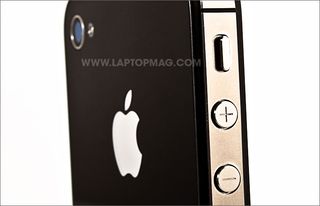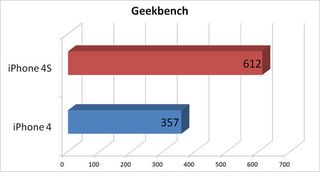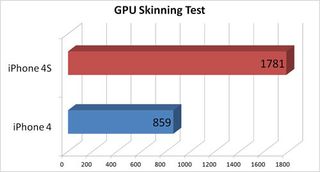Laptop Mag Verdict
The iPhone 4S is a superior smartphone, offering groundbreaking voice control, a fast dual-core processor, and a fantastic camera.
Pros
- +
Dual-core powerhouse
- +
Siri is a game-changer
- +
Fast, bright, and sharp camera
- +
iOS 5 and iCloud built in
- +
Relatively long battery life
Cons
- -
Lacks 4G data speeds
- -
No Facebook integration
- -
Photo Stream only works over Wi-Fi
Why you can trust Laptop Mag
The iPhone 4S is a triple threat, and not just because it's available on three out of the four major U.S. carriers. Thanks to an A5 processor, Apple's sequel for AT&T (starting at $199 for 16GB, $399 as reviewed for 64GB) is considerably faster than the iPhone 4. Second, the iPhone 4S sports a much sharper and brighter 8-megapixel camera, which records full HD video. And then there's Siri, a voice-enabled assistant so advanced she nearly sells the device by herself. Ask Siri, "What's the best smartphone?" and she'll tell you, "The one you're holding." But is the iPhone 4S really a step above everything else on the market? We'll answer that question.
Design
If HTC or Samsung shipped a flagship smartphone that looked identical to its predecessor more than a year later, they'd be ridiculed. The problem for them is that the iPhone 4S is still the best-designed device on the market. From the glass back to the stainless steel band that wraps around the outside, this handset looks as elegant and feels as solid as ever.

Click to enlarge
On the other hand, the iPhone 4S isn't the thinnest or lightest smartphone on the market anymore. Apple's device measures 4.5 x 2.3 x 0.4 inches and weighs 4.9 ounces, compared to 5.1 x 2.7 x 0.4 inches and 4.8 ounces for the Samsung Galaxy S II, whose screen is nearly an inch larger. Still, the Galaxy S II feels cheaper because of its plastic body. And the iPhone 4S' more compact dimensions make it easier to use with one hand.
Display
At 960 x 640 pixels, the iPhone 4S still sports the sharpest screen out there, although HD panels are on the way from the Android competition. Icons, text, photos, videos, and games look gorgeous on Apple's Retina display. The iPhone 4S' screen also continues to outshine nearly all the competition in terms of brightness.
In fact, this display is brighter and whiter than the iPhone 4's. As a result, we could make out more details in darker scenes of a Fringe episode, but some other images (such as photos taken in sunlight) looked a bit washed out. When we used our AEMC Lightmeter, the iPhone S notched 549 lux, versus 511 for the iPhone 4. The Sprint Galaxy SII only registered 284 lux.

Click to enlarge
Some may find the iPhone 4S' 3.5-inch display cramped compared to handsets with 4.3- or 4.5-inch screens. You simply don't have to zoom in as much to read content on web pages with a 800 x 480-pixel phone such as the Samsung Galaxy S II, and you have more surface area for a larger keyboard. Nevertheless, Apple's multitouch keyboard remains top-notch; we still have no problem typing accurately in portrait mode.
Dual-Core Performance
In a move that surprises no one, Apple packed the iPhone 4S with the same A5 dual-core processor that's inside the iPad 2. The result, according to the company, is up to two times the overall performance and up to 7 times the graphics muscle. The iPhone 4S notched a GeekBench Score of 612, versus 357 for the original iPhone 4 running iOS 5. That's a 1.7X difference.

Click to enlarge
In the GLBenchmark, which measures graphics performance, the iPhone 4S turned in similar scores to the iPhone 4 in some tests but outpaced it by a wide margin in others. For instance, in the GPU Skinning test, the iPhone 4S notched 1,781 to 859 for the iPhone 4 (a 2X difference), and there was nearly a 4X delta in single-textured fill rate.

Click to enlargeNow for real-world results. The A5 chip makes the iPhone 4S faster at rendering web pages. It beat the iPhone 4 when loading the full desktop versions of both the NYTimes (4 vs. 8 seconds) and ESPN.com (5 vs. 10 seconds) over Wi-Fi. However, the iPhone 4S had only a one-second edge on mobile sites such as CNN. The newer iPhone also starting playing HD YouTube trailers slightly faster, loaded Pandora about 3 seconds faster, and it took 6 seconds less to load the first level of the Asphalt 6 game.
You'll see the biggest performance boost with the iPhone 4S when playing demanding 3D games and editing video in iMovie. When we tried Infinity Blade, we enjoyed less lag when battling foes, similar to the bump we saw between the iPad and iPad 2. More games optimized for the A5 chip are on the way.
AirPlay Mirroring
There's one other benefit of the iPhone's dual-core processor, and that's mirroring capability via AirPlay. That means you can stream whatever is on your iPhone 4S's screen--whether it's a home movie, game, or slideshow--to an Apple TV. Apple says games such as Real Racing 2 will let up to four players compete on the big screen at the same time. No other smartphone can do that.
To test out mirroring, we connected the iPhone 4S to an Apple TV on the same Wi-Fi network, double-pressed the home button, and swiped to the left twice. Then we hit the AirPlay button and selected Apple TV. Photos looked crisp and colorful, and Asphalt 6 streamed smoothly enough to make turns and stay in the race--and get a little dizzy. However, we noticed some audio stuttering and pixelation, especially when we performed a turbo boost. 1080p videos took a while to buffer, but looked brilliant when they started playing. We could make out the text on a taxi door from about 10 feet away.
iOS 5
Although the iPhone 4S' iconic interface remains just as simple as ever, the underlying iOS 5 (also available for the older iPhone 4 and 3GS) packs a ton of welcome new features. Some of these enhancements play catch-up with Android and others surpass it.
Although you access the new Notification Center the same way you view notifications in Android--a swipe down from the top of the screen--Apple's dashboard looks cleaner and more modern. iOS 5 also integrates weather and stocks in the Notification Center, giving it a more dynamic feel. When you have incoming alerts, you can set them as banners that appear at the top of the screen, as opposed to in-your-face boxes that take up the center of the display. The iPhone 4S can also show notifications on the lock screen, such as new messages, enabling users to swipe to open the associated app.
| Click to enlarge | Click to enlarge |
Another helpful new feature is Reminders, which you can use to create a list of tasks. You can set the app to remind you either on a certain day or when you arrive to a specific location, such as "Take out the trash" when you get home. Unfortunately, you can only use addresses that are already stored in your contacts, and tasks don't integrate with the iPhone 4S' calendar.
Apple has finally started to catch up to Android in the social networking department with Twitter integration in iOS 5. You can tweet a web article, photo, map location, or YouTube video directly from the associated apps. When you go to share that content, you'll see a thumbnail of it on the right side and three blank lines where you'll compose your tweet. Before sending, you can add your location. Twitter also integrates with Contacts, so you'll see a contact's profile pic when you open their contact card.
Sadly, iOS 5 doesn't integrate with Facebook in the same ways, something Android phones have been doing for years. Instead, you'll need to use the dedicated Facebook app.
Other highlights of iOS 5 include the ability to access the camera from the lock screen, Newsstand for magazine and newspaper subscriptions, built-in photo editing tools, and (finally) the ability to sync iTunes content with your Mac or PC over Wi-Fi.
Siri
Up until now, voice control on phones has been limited to very specific pre-programmed commands, limiting its appeal and functionality. Siri is different. This breakthrough service--exclusive to the iPhone 4S--was designed to understand natural language and gets better at understanding your voice over time. What can you do with this virtual assistant? A lot more than you might think.
To activate Siri, you can either long-press the home button and then start speaking or simply bring the phone up to your head as if you were having a conversation. Actually, you are; with Siri you can string together queries that no other smartphone would understand, and she'll respond and interject when appropriate.
For instance, you could say, "What steakhouses are near me?" and Siri will ping Yelp for recommendations (pictured below left). Then you could say, "How about Mexican?" and she'll grab that information. Notice we only said "Mexican" and not "Mexican restaurants." This assistant understands context. In our case, Siri said, "I found 12 Mexican restaurants, six of them are fairly close to you." If you tap the result, you'll be brought to the Maps app. We wish we could jump right to Yelp.
| Click to enlarge | Click to enlarge |
Another example of Siri's amazing intelligence is the ability to create appointments just by saying, "Schedule lunch with John Monday at 1 p.m." Siri first asked me which John, presenting a list, and then she informed us that we already had a meeting schedule for that time. So we said. "Move it to 2 p.m," Calendar entry made. That's impressive.
Siri integrates with several of Apple's applications, including phone (for making calls), iPod, dictating messages, Reminders, Maps, Email, Weather (pictured bottom right), Stocks, Clock, Address Book, Web Search, and the new Find My Friends. We especially liked being able to set an alarm just by saying it aloud.
| Click to enlarge | Click to enlarge |
In addition to Yelp, Siri pulls in answers from WolframAlpha, the scary-smart online knowledge engine. For example, you can say, "What is a 20 percent tip on $90.33 for five people?" and Siri will give you the amount of the tip, total per person, and amount with tip. Siri also easily answered what movie won the Oscar in 2001 (Gladiator).
At times, though, Siri disappointed. She gave us directions to the nearest Longhorn Steakhouse, but only text on a map. iOS still doesn't provide spoken turn-by-turn GPS directions out of the box. In addition, while Siri can take dictation in any text field, she can't read your messages aloud. We'd also love to see Apple open up APIs for Siri so more developers can leverage this assistant's potential. We can't wait to be able to say things like, "What's my flight status?", "Book a table for two at Masa on Friday at 9 p.m.", and "What's the score of the Eagles game?"
At one point during our testing, Siri refused to work, responding with an "Uh oh." Rebooting the phone didn't help, but turning Siri off and then on in Settings fixed the issue. Overall, Siri is much more than a novelty, and we can't wait to see what Apple does with the feature next.
iCloud
iCloud confuses a lot of consumers; it's not just an online locker. Perhaps the best way to explain iCloud is how it works with photos. When you snap a picture with the iPhone 4S, the Photo Stream feature will automatically upload it to iCloud and then push it to your iPad, Mac, and Apple TV without you having to lift a finger. The images appear in those other places almost immediately, like magic. While we wish Photo Stream worked over 3G as well as Wi-Fi, it's a good example of why iCloud makes life easier.
| Click to enlarge | Click to enlarge |
Photo Stream stores only the last 1,000 pics you snapped, and you can't delete them once they're uploaded. That's annoying, so you'll want to make sure to delete any duds or embarrassing images before they reach iCloud.
With the iPhone 4S, iTunes is also in the cloud (pictured above right). When you purchase music or videos on your computer, you can download them again to your phone without paying for content twice. You can also automatically download music, apps, and books to all of your iOS devices at once (if you turn on that feature under Settings/Store). iTunes Match is coming soon, and it will scan your music collection for tracks you haven't purchased and add them to the cloud--no uploading required--for $24.99 per year. You can also sync your existing iTunes collection to your iPhone 4S over Wi-Fi.
iCloud also backs up your iPhone 4S; it keeps your calendar, mail, and contacts in sync across devices, and help you find your phone (just as before).
Apple includes 5GB of storage for free, and purchased content (music, apps, books, TV shows) and Photo Stream don't count against that cap. But you can upgrade to yearly subscriptions of $20 for 10GB, $40 for 20GB, or $100 for 50GB. Photo Stream stores only the last 1,000 pics you snapped, and you can't delete them once they're uploaded. That's annoying, so you'll want to make sure to delete any duds or embarrassing images before they reach iCloud.
Camera and Camcorder
Apple boasts that the 8-MP camera inside the iPhone 4S is the best around, but it's not just about having more pixels. The phone has a new custom lens with a larger f/2.4 aperture paired with an even better backside illumination sensor and a new Hybrid IR filter. Just as important, the iPhone 4S starts nearly two seconds faster than the iPhone 4 and the shot-to-shot time was much snappier. In fact, the iPhone 4S narrowly beat the Sprint Galaxy S II in this category and was speedier than the Amaze 4G. (The Amaze 4G's camera started up fastest, though, thanks to its dedicated camera button.)
When we took a shot of a painting indoors, the iPhone 4S trounced the Samsung Galaxy S II and HTC Amaze 4G--both great camera phones. Apple's camera delivered a clearer and far brighter image. When we took all three handsets outdoors to shoot a pumpkin and other Halloween decorations, the iPhone 4S outclassed the Amaze 4G but was neck and neck with the Galaxy S II in detail--right down to a sculpted flower on the side of a pot. Still, the orange was slightly brighter on the iPhone 4S shot.

Click to enlarge
To help you make your photos look their best, iOS 5 includes a Grid feature to line up shots, as well as HDR functionality for avoiding overexposed or underexposed shots. After you take the pic, you can use the new Edit button and then engage Auto Enhance, remove red eye, or crop photos. The Amaze 4G goes further with some of its features, such as its Panorama mode and Burst mode.

Click to enlarge
The iPhone 4S' 1080p camcorder is yet another reason to leave your point-and-shoot behind. When we recorded a three-year-old having fun on a playground, we could easily make out the intricate design of a slide's exterior and the folds in the boy's cargo pants. The audio was a little soft at medium distance, but loud as the subject moved closer.
In a separate video we shot alongside the Galaxy S II and Amaze 4G, the iPhone 4S did a better job handling transitions from darker to lighter areas, but the S II delivered comparable detail and smoother footage when tracking moving objects.
Apps and Media
The App Store now has an unprecedented 500,000 apps, 360,000 of which are for the iPhone. But some of the most compelling apps for the iPhone 4S are made by Apple, including the new iMessage (pictured below left). This BlackBerry Messenger rival sends messages instantly and for free to any iOS device running iOS 5. And you can share a lot more than just text; iMessage supports photos, videos, and web links. It took only 25 seconds to send a picture over Wi-Fi. You can also see when someone is typing a reply.
| Click to enlarge | Click to enlarge |
Apple's new Find My Friends app (a free download, pictured above right) leverages iCloud to help you pinpoint family members and others who own iOS 5 devices with this feature enabled. You can invite friends and family right from the app. And if you'd rather not broadcast your coordinates at all times, you can choose to share your location temporarily by entering a specific day and time.
The iPhone 4S' selection of third-party apps continues to be unparalleled. Even though Android has many of the same apps, Apple's continue to be more polished. A good example is the redesigned Facebook app (pictured below left), which has a slick slide-out menu bar. The iPhone 4S also taps into a better selection of games, including console-like titles such as ShadowGun.
| Click to enlarge | Click to enlarge |
While Android phones have started to close the gap with media integration, only the iPhone 4S lets you buy music, books, magazines (Newsstand pictured above right), movies, and TV shows with a single account. It's hard to beat that sort of convenience, though we wish Apple would pull a Spotify and/or Netflix and offer subscription plans for tunes and video.
Data and Web Surfing

Click to enlarge
Thanks to a new dual-antenna design, the iPhone 4S can switch between two antennas for sending and receiving data. The reason we wanted to review the AT&T model, though, is that only this version supports HSDPA data speeds up to 14.4 Mbps. In one New Jersey location we saw download speeds as high as 5.3 Mbps, but overall the phone averaged 2.2 Mbps, far below competing devices that offer true 4G speeds. Both the T-Mobile Galaxy SII (12.6 Mbps) and the Motorola Droid Bionic (11.6 Mbps) were more than five times faster, and the Sprint Galaxy S II was about twice as speedy. The AT&T Galaxy S II averaged 4.5 Mbps down in one NYC location.
When surfing the web, the iPhone 4S was also slower than bonafide 4G smartphones. It took the handset 10 seconds to load the mobile version of ESPN, 12 seconds for CNN Mobile, and 23 seconds for the full version of NYTimes.com. By contrast, Verizon and T-Mobile's latest 4G phones take less than 5 seconds to load mobile sites and 10 seconds or less for the full NYTimes.
The good news is that you'll see faster page load times than offered by the iPhone 4 (thanks to the A5 dual-core processor), and Safari now sports a cool new Reader feature that strips pages of ads and blows up text to make articles easier to read. Want to keep on top of multiple stories you want to get to later? Add an article to the new Reading List, which is separate from Bookmarks.
Call Quality and Battery Life
After making multiple calls over three days, we're happy to report that the iPhone 4S dropped only one call. Audio quality on our end of the line was fuzzy during pauses, but otherwise clear and plenty loud. Other callers said we sounded "just fine," which is pretty good compared to earlier AT&T iPhones.
The iPhone 4S has a rated battery life of 8 hours of talk time, an hour more than its predecessor. However, the standby time is 200 hours, down from 300 hours on the iPhone 4. In our daily testing, the iPhone 4S had impressive endurance despite packing a dual-core processor. After using the phone intermittently from 7 AM until 5 PM, the device still had 38 percent of its charge left, so you should be able to get through most, if not all, of an average work day on a charge. We'll update this review once we've run our formal battery test.
Verdict
Click to enlarge
Yes, it's a dead ringer for the iPhone 4, but the iPhone 4S serves as a reminder that true innovation is never skin deep. With Siri, Apple has managed to make voice control not only natural but cool. The sharper and brighter camera, smooth 1080p camcorder, and zippier dual-core processor all solidify the iPhone 4S as the best phone on AT&T. iPhone 4 owners in the middle of their contracts are likely better off waiting for the iPhone 5, as iOS 5 and iCloud will extend the life of your device.
Those looking for a bigger display might prefer the Android-powered Samsung Galaxy S II, which offers a larger screen and some key features the iPhone 4S lacks, such as true 4G speeds (on Sprint and T-Mobile) and Facebook integration. Where the iPhone 4S pulls ahead is ease of use, app selection, and an ever-growing army of accessories. And then there's the features only Apple could pull off. You know, the kind that get people excited about talking to their phones again.
Apple iPhone 4S (AT&T) Specs
| Bluetooth Type | Bluetooth 4.0 |
| Brand | Apple |
| CPU | Apple A5 |
| Camera Resolution | 8 MP |
| Carrier | AT&T |
| Company Website | http://www.apple.com |
| Data | EV-DO Rev. A |
| Display (main) | 3.5-inch qHD Retina (960 x 640) |
| Form Factor | Candybar Touchscreen |
| Front Camera Resolution | VGA |
| GPS | Yes |
| Internal Memory | 16GB |
| Memory Expansion Type | none |
| Networks | GSM/EDGE (850, 900, 1800, 1900 MHz) |
| Operating System | iOS 5.0 |
| Ports | 3.5mm headphone, Proprietary |
| RAM | 512MB |
| Size | 4.5 x 2.3 x 0.37 inches |
| Talk / Standby Time | 8 hours (3G), 14 hours (GSM)/200 hours |
| Weight | 4.9 ounces |
| Wi-Fi | 802.11n |
